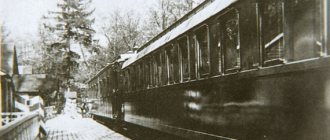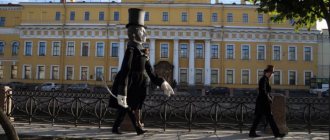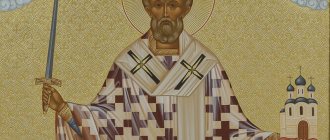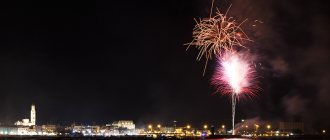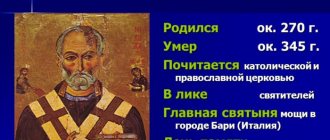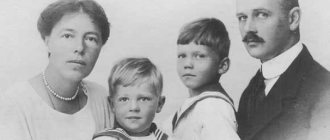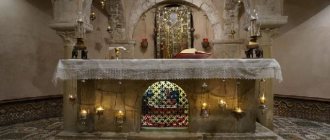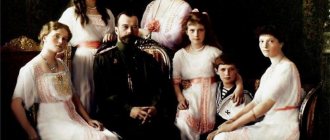On December 12, Channel One will show the 8-episode film “Gregory R” (2014), dedicated to the last days of the reign of Emperor Nicholas II, as well as one of the most mysterious close associates of the royal family - elder Grigory Rasputin. Nicholas II and his family (wife and children) are the last representatives of the House of Romanov and the last rulers of the Russian Empire, shot by the Bolsheviks in July 1918.
In Soviet textbooks, the autocrat was presented as a “strangler of freedoms” who was not interested in state affairs, and the Russian Orthodox Church (though already in our days) canonized the tsar as a martyr and passion-bearer. Let's figure out how modern historians evaluate the life and reign of Nicholas II.
Life and reign of Nicholas II
Tsar Nicholas II |
Tradition Nicholas, the eldest son of Emperor Alexander III, was born in Tsarskoe Selo on May 6 (18), 1868. The heir to the throne received a thorough education at home: he knew several languages, world history, and understood economics and military affairs. Together with his father, Nikolai made many trips to the provinces of Russia.
Nicholas II in childhood | Tradition
Alexander III did not make concessions: he wanted his offspring to behave like ordinary children - they played, fought, sometimes played pranks, but most importantly, they studied well and “didn’t think about any thrones.”
Contemporaries described Nicholas II as very easy to communicate with, full of true dignity as a person. He never interrupted his interlocutor or raised his voice, even to those of lower rank. The emperor was lenient towards human weaknesses and had a good-natured attitude towards ordinary people - peasants, but he never forgave what he called “dark money matters”.
In 1894, after the death of his father, Nicholas II ascended the throne. The years of his reign came during a turbulent period in history. Revolutionary movements arose all over the world, and the First World War began in 1914. However, even in such difficult times, he managed to significantly improve the economic situation of the state.
Family of Nicholas II: the emperor and his wife Alexandra Feodorovna | Arguments and Facts
Here are just some facts about the reign of Nicholas II:
- During his reign, the population of the empire increased by 50 million people.
- 4 million rubles, left by Alexander III as an inheritance to his children and kept in a London bank, were spent on charity.
- The emperor approved all petitions for pardon that were sent to him.
- The grain harvest has doubled.
- Nicholas II carried out a military reform: he shortened the terms of service, improved living conditions for soldiers and sailors, and also contributed to the rejuvenation of the officer corps.
- During the First World War, he did not sit in the palace, but took command of the Russian army, finally managing to repel Germany.
Royal family of Nicholas II |
Kommersant However, the emerging revolutionary sentiments increasingly captured people’s thoughts. On March 2, 1917, under pressure from the high command, he handed over the Manifesto of Abdication, in which he bequeathed the army to obey the Provisional Government.
Modern historians believe that the Manifesto was a fake. In the original draft, Nicholas II only called for listening to your superiors, maintaining discipline and “defending Russia with all your might.” Later, Alekseev only added a couple of sentences (“For the last time I am addressing you...”) to change the meaning of the autocrat’s words.
Alternative versions of the tragedy
A key alternative version of this historical event is outlined in the book “The Murder That Never Happened” by Tom Mangold and Anthony Summers. It states the hypothesis that there was no execution. In general terms the situation is as follows...
- The reasons for the events of those days should be sought in the Brest-Litovsk Peace Treaty between Russia and Germany. The argument is that despite the fact that the secrecy stamp on the documents had long been removed (it was 60 years old, that is, there should have been publication in 1978), there is not a single complete version of this document. Indirect confirmation of this is that the “executions” began precisely after the signing of the peace treaty.
- It is a well-known fact that the wife of Nicholas 2, Alexandra, was a relative of the German Kaiser Wilhelm 2. It is assumed that Wilhelm 2 introduced a clause into the Treaty of Brest-Litovsk, according to which Russia undertakes to ensure the safe exit to Germany of Alexandra and her daughters.
- As a result, the Bolsheviks handed over the women to Germany, and left Nicholas 2 and his son Alexei as hostages. Subsequently, Tsarevich Alexei grew up into Alexei Kosygin.
Stalin gave a new twist to this version. It is a well-known fact that one of his favorites was Alexey Kosygin. There are no big reasons to believe this theory, but there is one detail. It is known that Stalin always called Kosygin nothing more than “prince.”
Wife of Nicholas II - Alexandra Feodorovna
Empress Alexandra Feodorovna - wife of Nicholas II |
Subscription to publications Empress Alexandra Feodorovna (nee Princess Alice of Hesse-Darmstadt) was born on May 25 (June 6), 1872. She received a new name after baptism and marriage to Nicholas II. The future empress was raised by the English Queen Victoria, who adored her granddaughter.
Alice graduated from the University of Heidelberg with a Bachelor of Philosophy.
In May 1884, at the wedding of her sister Elizaveta Fedorovna, she met Nikolai Alexandrovich. The wedding took place on November 14 (26), 1894, just 3 weeks after the death of Emperor Alexander.
During the war, Empress Alexandra and the Grand Duchesses personally assisted in operations in hospitals, accepted amputated limbs from surgeons and washed purulent wounds.
Empress Alexandra Feodorovna and Nicholas II |
Arguments and Facts Despite the fact that the empress was not popular in her new fatherland, she herself fell in love with Russia with all her soul. Doctor Botkin’s daughter wrote in her diary that after Nicholas II read out the manifesto on the war with Germany (her historical homeland), Alexandra cried with joy.
However, liberals considered her the head of the court Germanophile group and accused Nicholas II of being too dependent on his wife’s opinion. Because of the negative attitude, the once sparkling joy of the princess, the “Windsor ray of sunshine” (as Nicholas II called Alexandra in his time) gradually became isolated in a narrow circle of her family and 2-3 close associates.
Her friendship with the elder, Siberian peasant Grigory Rasputin, caused a lot of controversy.
Arrest of members of the royal family
Nicholas 2, having abdicated the throne, put forward fairly simple demands, the implementation of which was guaranteed by the Provisional Government. The requirements were the following:
- The emperor's safe transfer to Tsarskoe Selo to his family, where at that time Tsarevich Alexei was no longer there.
- The safety of the entire family during their stay in Tsarskoye Selo until Tsarevich Alexei’s complete recovery.
- Safety of the road to the northern ports of Russia, from where Nicholas 2 and his family must cross to England.
- After the end of the Civil War, the royal family will return to Russia and live in Livadia (Crimea).
These points are important to understand in order to see the intentions of Nicholas 2 and subsequently the Bolsheviks. The emperor abdicated the throne so that the current government would ensure his safe exit to England.
What is the role of the British government?
The provisional government of Russia, after receiving the demands of Nicholas 2, turned to England with the question of the latter’s consent to host the Russian monarch. A positive response was received. But here it is important to understand that the request itself was a formality. The fact is that at that time an investigation was underway against the royal family, during which time travel outside Russia was impossible. Therefore, England, by giving consent, did not risk anything at all. Something else is much more interesting. After the complete acquittal of Nicholas 2, the Provisional Government again makes a request to England, but this time more specific. This time the question was posed not abstractly, but concretely, because everything was ready for moving to the island. But then England refused.
Therefore, when today Western countries and people, shouting at every corner about innocent people killed, talk about the execution of Nicholas 2, this only causes a reaction of disgust at their hypocrisy. One word from the English government that they agree to accept Nicholas 2 and his family, and in principle there would be no execution. But they refused...
In the photo on the left is Nicholas 2, on the right is George 4, King of England. They were distant relatives and had obvious similarities in appearance.
Children of Nicholas II
Nicholas II and his children |
Sites - Google The family of Nicholas II Romanov raised five children: four daughters (Olga, Tatiana, Maria, Anastasia) and a son, the heir to the throne, Alexei Nikolaevich.
Olga Nikolaevna Romanova
Family of Nicholas II - Grand Duchess Olga Nikolaevna |
Wikipedia Olga, the eldest daughter of Nicholas II, gave the impression of a gentle and fragile girl. From an early age she showed a passion for books and was a very erudite child. However, at times the Grand Duchess was hot-tempered and stubborn. Teachers noted that the girl had an almost perfect ear for music - she could play almost any melody heard somewhere.
Princess Olga did not like luxury and was distinguished by modesty. She didn’t like housework, but she enjoyed reading, playing the piano and drawing.
Tatyana Nikolaevna Romanova
Family of Nicholas II - Grand Duchess Tatyana Nikolaevna |
Wikipedia Tatyana Nikolaevna was born on May 29, 1897. As a child, what she loved most was riding a pony and a tandem bicycle with her sister Olga; she could spend hours wandering around the garden, picking flowers and berries.
Tatyana's character was similar to her mother: she laughed less often than the other sisters, and was often thoughtful and strict.
Unlike her older sister, the girl loved to be in charge, and she was great at it. When her mother was away, Tatyana embroidered, ironed clothes and managed to look after the younger children.
Maria Nikolaevna Romanova
Family of Nicholas II - Grand Duchess Maria Nikolaevna |
Wikipedia The third daughter in the family of Nicholas II - Maria - was born on the night of June 14, 1899 at the summer residence in Peterhof. Very large and strong for her age, she later carried her brother Alexei in her arms when it was difficult for him to walk. Because of her simplicity and cheerful disposition, the sisters called her Masha. The girl loved to talk with the guard soldiers and always remembered the names of their wives and how many children they had.
At the age of 14 she became a colonel of the 9th Kazan Dragoon Regiment. At the same time, her affair with officer Demenkov broke out. When her lover went to the front, Maria personally sewed a shirt for him. In telephone conversations, he assured that the shirt was just right. Unfortunately, the end of the love story was tragic: Nikolai Demenkov was killed during the civil war.
Anastasia Nikolaevna Romanova
Family of Nicholas II - Grand Duchess Anastasia Nikolaevna |
Wikipedia Princess Anastasia was born when the family of Nicholas II and Alexandra already had three daughters. Outwardly she looked like her father, she often laughed and laughed loudly. From the diaries of those close to the royal family, you can find out that Anastasia had a very cheerful and even mischievous character. The girl loved to play lapta and forfeits, could tirelessly run around the palace, play hide and seek, and climb trees. But she was never particularly diligent in her studies and even tried to bribe teachers with bouquets of flowers.
Alexey Nikolaevich Romanov
Family of Nicholas II - son Alexey Nikolaevich |
Wikipedia The long-awaited son of Nicholas II and Alexandra Feodorovna was the youngest of the children of the royal couple. The boy was born on July 30 (August 12), 1904. At first, the Tsarevich grew up as a cheerful, cheerful child, but later a terrible genetic disease appeared - hemophilia. This complicated the upbringing and training of the future emperor. Only Rasputin managed to find a way to alleviate the boy’s suffering.
Alexei Nikolaevich himself wrote in his diary: “When I am king, there will be no poor and unhappy people, I want everyone to be happy.”
Message to the last king
Nicholas II was always attracted by the unknown and mystical. Once, during a trip to Sarov in 1903, he was given a letter written by the Monk Seraphim of Sarov himself in 1832. The envelope was signed with the words: “To the last king.” The emperor did not immediately tear off the letter; he went with his retinue and the empress to the blessed Pasha of Sarov.
Eyewitnesses recalled that during a visit to the blessed empress, she shouted that she did not believe her and burst into tears. The family was depressed, and in the evening the emperor opened a letter from Seraphim of Sarov. In it, the monk indicated that the last reign had begun, that difficult times were coming for the country, and that the emperor himself and members of his family would face death.
Execution of Nicholas II and his family
Royal family of Nicholas II |
All of Switzerland in the palm of your hand After the signing of the manifesto, from March 9 to August 14, 1917, the royal family of Nicholas II lived under arrest in Tsarskoe Selo. In the summer they were transported to Tobolsk, where the regime was a little softer: the Romanovs were allowed to go across the street to the Church of the Annunciation and lead a quiet home life.
While imprisoned, the family of Tsar Nicholas II did not sit idle: the former monarch personally chopped wood and looked after the garden.
In the spring of 1918, the All-Russian Central Executive Committee decided to transfer the Romanov family to Moscow for trial. However, it never took place. On July 12, the Ural Council of Workers' Deputies decided to execute the former emperor. Nicholas II, Alexandra Fedorovna, their children, as well as Doctor Botkin and the servants were shot in Yekaterinburg in the “House of Special Purpose” on the night of July 17, 1918.
Background of events
We should start with the fact that Nicholas 2 was not the last Russian emperor, as many believe today. He abdicated the throne (for himself and for his son Alexei) in favor of his brother, Mikhail Romanov. So he is the last emperor. This is important to remember; we will return to this fact later. Also, in most textbooks, the execution of the royal family is equated with the murder of the family of Nicholas 2. But these were not all Romanovs. To understand how many people we are talking about, I will give only data on the last Russian emperors:
- Nicholas 1 – 4 sons and 4 daughters.
- Alexander 2 – 6 sons and 2 daughters.
- Alexander 3 – 4 sons and 2 daughters.
- Nikolai 2 – son and 4 daughters.
That is, the family is very large, and anyone from the list above is a direct descendant of the imperial branch, and therefore a direct contender for the throne. But most of them also had children of their own...
